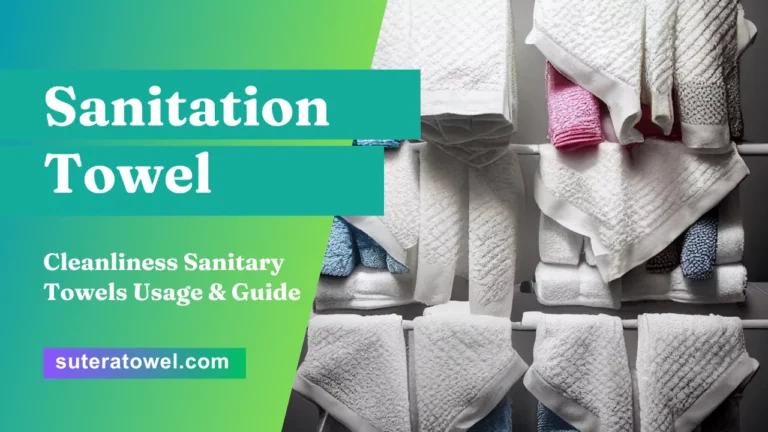A sanitation towel is a hygienic cloth used for cleaning surfaces to prevent the spread of germs and bacteria. It is an essential tool for maintaining cleanliness and preventing the transmission of illnesses in various settings, such as homes, hospitals, offices, and restaurants.
Sanitation towels are designed with durable materials that effectively absorb liquids and trap particles, ensuring thorough cleaning. These versatile towels can be used with cleaning solutions or water and are suitable for a wide range of surfaces, including countertops, tables, floors, and equipment.
By using sanitation towels regularly, you can maintain a clean and healthy environment, reducing the risk of contamination and promoting overall hygiene.
- 1 History Of Sanitation Towel
- 2 What Are Sanitation Towels?
- 3 How to Use a Sanitation Towel?
- 4 Improved Hygiene Practices
- 5 Environmental Impact
- 6 Cost And Efficiency
- 7 Microfiber Towels
- 8 Disposable Paper Towels
- 9 Bamboo Towels
- 10 Choose The Right Towel For The Task
- 11 Sanitation Towel Maintenance
- 12 Tips For Optimal Cleanliness
- 13 Hospitality And Food Service
- 14 Healthcare Facilities
- 15 Office Spaces
- 16 Frequently Asked Questions Of Sanitation Towel
- 17 Conclusion
History Of Sanitation Towel
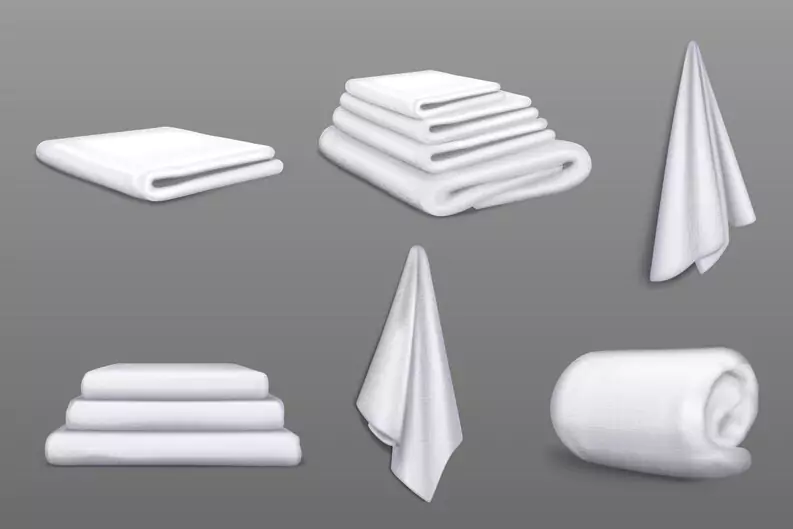
Sanitary towels, also known as sanitary napkins or pads, have a history dating back hundreds of years. The ancient Egyptians used softened papyrus as an absorbent material, while the Greeks and Romans utilized wool and other fabrics. Fast forward to the late 19th century, and disposable sanitary towels as we know them today started gaining popularity.
What Are Sanitation Towels?
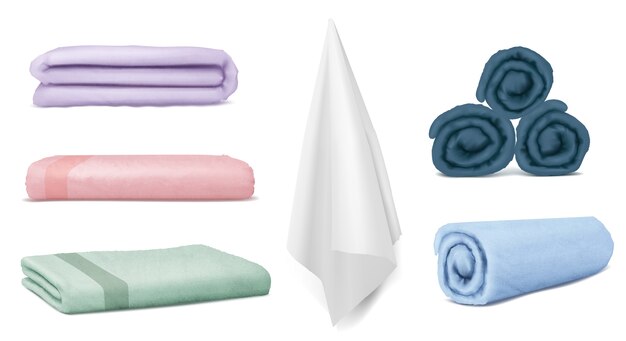
Women wear sanitary towels or napkins, which are absorbent pads, during their period to control the flow of blood. These towels are worn inside underwear to soak menstrual blood cleanly and easily.
Sanitation towels come in many different shapes, sizes, and thicknesses, so people can choose what they like. Menstrual fluid is soaked up by layers made of cotton, cellulose, or synthetic fibers. This keeps the user dry.
Sanitation rags are meant to be used just once and then thrown away. Modern sanitary wipes have an adhesive back that sticks to underwear, so they don’t move when you work out.
Sanitation blankets are a common way to stay clean and comfortable during your period. Many people around the world need them, and they come in different brands and styles to fit different tastes.
Web Stories for Sanitation Towels
How to Use a Sanitation Towel?
Prerequisites:
- Pristine and dry sanitation towel
- Hygienic hands
Procedure:
- Hand Hygiene: Commence by cleansing your hands diligently, ensuring an immaculate and dry state. Adhering to stringent hand hygiene practices is crucial to averting potential contamination.
- Unwrapping the Sanitary Towel: If the sanitary towel is individually enclosed, cautiously initiate the unwrapping process. Exercising gentleness is paramount to circumventing any inadvertent harm to the pad.
- Orientation of the Sanitary Towel: Discern the absorptive facet of the pad. Typically, this side possesses increased thickness and may incorporate lateral wings designed to fold over the contours of your undergarments, augmenting safeguards against potential seepage.
- Peeling Off the Backing: If the sanitary towel features an adhesive backing, carefully peel away the safeguarding layer to reveal the adhesive side. This adhesive surface is intended to affix the pad to your undergarments, thereby ensuring stability during usage.
- Placement within Undergarments: Grasp the pad from its lateral extremities with the adhesive side facing downward. Position the pad centrally within your undergarments, aligning the absorptive side upward. If the pad incorporates wings, envelop them over the edges of your undergarments to secure the pad steadfastly in position.
- Customizing for Comfort: Verify that the pad is symmetrically situated and affords a comfortable fit within your undergarments. If necessary, make any adaptations to guarantee a snug placement.
- Disposing of Packaging: Discard any packaging or protective backing materials in a designated receptacle designated for sanitary waste disposal. Never flush these items down a toilet.
- Hand Sanitization Redux: Following the secure placement of the sanitary towel within your undergarments, conduct an additional cycle of hand sanitation. Employ soap and water to ensure optimal cleanliness.
- Scheduled Replacements: Depending on the intensity of your menstrual flow, anticipate changing the sanitary towel at regular intervals. Consistently renew the pad to sustain freshness and forestall potential leakage.
- Management of Used Pads: When you deem it necessary to replace the sanitary towel, adroitly disengage it from your undergarments. If you find yourself in a public restroom, consider enshrouding it in tissue or toilet paper. Dispose of the used pads in a specifically designated sanitary waste receptacle or within a hermetically sealed plastic bag. Never attempt to flush these items down a toilet, as they possess the potential to obstruct plumbing infrastructure.
By meticulously adhering to these instructions, one can adeptly employ a sanitary towel for the efficient management of menstrual flow while simultaneously upholding standards of cleanliness and comfort during the menstruation phase.
Here is a table of the uses of sanitation towels, with their pros and cons:
| Use of Sanitation Towel | Pros | Cons |
|---|---|---|
| Cleaning and disinfection: Sanitation towels can be used to clean and disinfect surfaces, such as countertops, tables, and floors. They are also effective at removing germs and bacteria. | Sanitation towels are disposable, so they help prevent the spread of germs. | Sanitation towels can be expensive, especially if used frequently. |
| Absorbing liquid: Sanitation towels can be used to absorb liquids such as spills, leaks, and vomit. They can also be used to clean up blood and other bodily fluids. | Sanitation towels are absorbent, so they can help prevent messes from spreading. | Sanitation towels can be bulky and difficult to dispose of. |
| Protecting surfaces: Sanitation towels can be used to protect surfaces from contamination. For example, they can be used to cover a wound or protect a mattress from bedwetting. | Sanitation towels can help prevent the spread of germs. | Sanitation towels can be expensive, especially if used frequently. |
| First aid: Sanitation towels can be used for first aid purposes, such as cleaning wounds and applying pressure to bleeding. | Sanitation towels are sterile, so they can help prevent infection. | Sanitation towels can be expensive, especially if used frequently. |
Improved Hygiene Practices
With the use of sanitation towels, improved hygiene practices are achieved by effectively eliminating germs and bacteria. These towels provide a convenient and hygienic solution for maintaining cleanliness in various settings.
Maintaining clean and hygienic environments is crucial for preventing the spread of bacteria, germs, and infections. By implementing sanitary Towels into your daily routine, you can significantly improve hygiene practices. Let’s explore the benefits:
Reduction In Bacteria And Germs:
- Sanitation Towels are treated with special anti-microbial agents, effectively reducing the growth of bacteria and germs.
- These towels provide a physical barrier that helps prevent the transfer of harmful microorganisms.
- By using sanitary Towels, you can minimize the risk of spreading pathogens and maintain a healthier environment.
Prevention Of Infections And Diseases:
- Sanitation Towels have been designed to help prevent infections and diseases associated with poor hygiene practices.
- With their anti-bacterial properties, these towels provide an extra layer of defense, protecting you and others from potential harm.
- Regular usage of Sanitation Towels can help reduce the transmission of infectious agents and minimize the risk of illness.
By incorporating Sanitation Towels into your daily routine, you are taking proactive steps to improve hygiene practices, reduce bacteria and germs, and prevent infections and diseases. Remember, maintaining cleanliness and practicing good hygiene are essential for overall well-being. Stay safe and healthy!
Environmental Impact
Sanitation towels have a significant environmental impact due to their non-biodegradable materials and high production volume. Their disposal contributes to landfill waste and pollution, making it crucial to explore sustainable alternatives.
Understanding Sanitary Towels
Sanitation towels offer several benefits for minimizing environmental impact. By adopting the use of these towels, there is a decreased reliance on disposable paper towels, leading to a reduction in waste and landfills. Let’s take a closer look at these environmental advantages:
- Decreased use of disposable paper towels:
- By switching to sanitation towels, less reliance on disposable paper towels is needed.
- Reduced consumption of paper towels helps conserve natural resources.
- Fewer trees are cut down, as well, and less water and energy are required for their production.
- Reduction in waste and landfill:
- Sanitation towels can be reused multiple times before being disposed of.
- The decreased use of disposable paper towels means less waste is generated overall.
- Waste reduction contributes to a decrease in landfill usage and its associated environmental impact.
- Lower carbon footprint:
- With sanitation towels, there is no need for continuous production and transportation of disposable paper towels.
- By reducing the demand for paper towels, the associated carbon emissions from manufacturing and transportation are significantly reduced.
- Sustainable choice:
- Sanitation towels can be washed and reused, making them a more sustainable option compared to single-use paper towels.
- Choosing sanitation towels over disposable alternatives aligns with eco-friendly behaviors and promotes a circular economy approach.
The use of sanitation towels positively impacts the environment by decreasing the use of disposable paper towels, reducing waste and landfills, and lowering the carbon footprint. By opting for this sustainable choice, individuals can contribute to a greener future while maintaining cleanliness and hygiene.
Cost And Efficiency
Maintaining cost and efficiency, the sanitation towel provides an effective solution for ensuring cleanliness and hygiene while reducing expenses. With its practical design and high-performance features, it offers a reliable option for maintaining a sanitary environment.
Cost-Effective Solution
Sanitation towels are a cost-effective solution for maintaining cleanliness in various environments. Whether it’s a commercial space, a healthcare facility, or even at home, these towels offer several advantages in terms of cost and efficiency. Let’s take a closer look at how sanitation towels can provide a budget-friendly and effective solution:
- Cost savings: Sanitation towels can save significant costs when compared to traditional cleaning methods. Here’s how:
- Reusability: These towels are reusable, reducing the need for frequent purchases of disposable cleaning materials.
- Durability: Designed to withstand multiple uses, sanitation towels offer a long lifespan, avoiding the need for frequent replacements.
- Efficient cleaning: With their high absorption capacity, sanitation towels effectively clean surfaces with minimal waste.
- Reduced dependency on cleaning agents: Sanitation towels can be used with or without cleaning agents, providing flexibility in your cleaning routine. By using fewer chemicals, you not only reduce your expenses on cleaning agents but also contribute to a healthier and more environmentally friendly space.
- Versatility in application: Sanitation towels are suitable for various cleaning tasks, making them a versatile solution for different environments. Whether you’re wiping down surfaces, mopping floors, or even cleaning delicate equipment, these towels can handle a wide range of cleaning applications.
Time-Saving In Maintaining Cleanliness
In addition to the cost benefits, sanitation towels offer time-saving advantages when it comes to maintaining cleanliness. Here’s how they can help save you time and effort:
- Quick and efficient cleaning: Sanitation towels are designed to be highly absorbent and effective in picking up dirt, debris, and spills. This efficiency translates into quicker cleaning times, allowing you to cover larger areas efficiently.
- Convenient and easy to use: These towels are typically lightweight and easy to handle, enabling fast and hassle-free cleaning. Whether you’re an individual cleaning at home or a professional janitorial service, sanitation towels provide a convenient cleaning solution.
- Reduced cleaning time: The efficiency of sanitation towels means fewer passes are required to achieve a clean surface. This reduction in cleaning time allows you to focus on other tasks or move on to additional cleaning areas, increasing overall productivity.
- Enhanced hygiene maintenance: By using sanitation towels, you ensure that surfaces are thoroughly cleaned and sanitized. This not only promotes a healthy environment but also reduces the risk of cross-contamination, saving you additional time spent on re-cleaning or addressing hygiene issues.
- Minimized drying time: Sanitation towels are designed to absorb excess moisture effectively. This feature helps in reducing drying time for surfaces, allowing them to be ready for use sooner.
Sanitation towels are a cost-effective and time-saving solution for maintaining cleanliness in various settings. The combination of cost savings, reduced dependency on cleaning agents, versatility in application, quick cleaning, convenience, enhanced hygiene maintenance, and minimized drying time make these towels a valuable addition to any cleaning routine.
Microfiber Towels
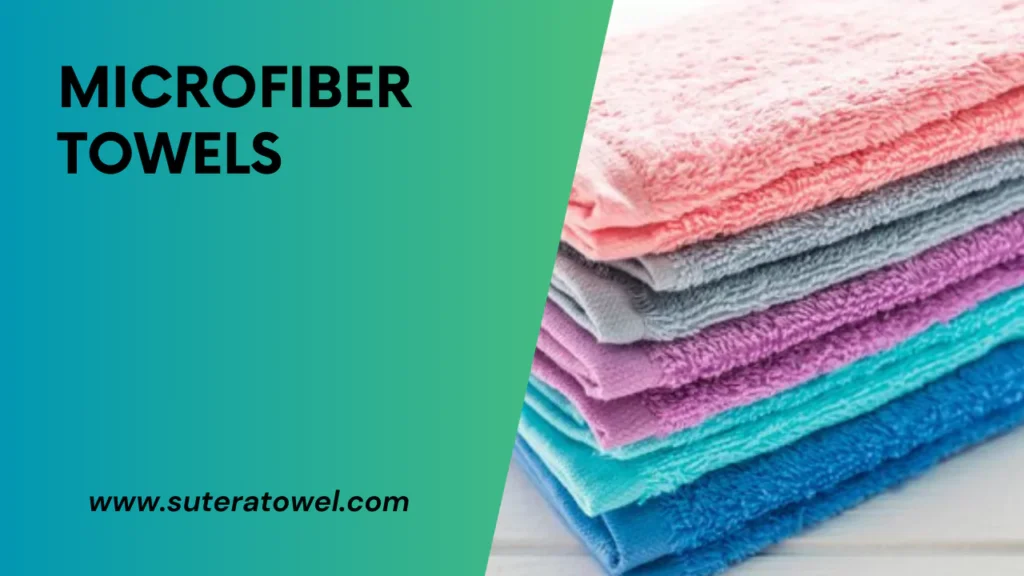
Microfiber towels offer superior sanitation capabilities, making them ideal for maintaining cleanliness in various settings. With their excellent absorbency and antimicrobial properties, these towels provide an effective solution for ensuring hygiene and reducing the spread of germs.
Superior Absorbency And Cleaning Power
Microfiber towels are renowned for their superior absorbency and cleaning power. Here are some reasons why they excel in these areas:
- Microfiber towels have microscopic fibers that are highly efficient in absorbing liquids. These fibers create more contact points, allowing the towel to quickly and effectively soak up liquids, whether it’s water, cleaning solutions, or spills.
- The dense structure of microfiber towels helps trap dirt, dust, and other particles within the fibers, preventing them from being spread around during cleaning. This makes them ideal for various cleaning tasks, from wiping countertops and surfaces to drying dishes and glassware.
- Due to their absorbent nature, microfiber towels leave surfaces cleaner and drier than traditional towels or cloths. They effectively remove moisture, dirt, and grime, leaving a streak-free and sparkling finish.
- Microfiber towels are capable of holding multiple times their weight in liquid, making them highly efficient for larger cleaning tasks. You can easily tackle spills, dry wet surfaces, or even use them for deep cleaning projects.
- Whether you’re cleaning windows, mirrors, or other delicate surfaces, microfiber towels provide exceptional cleaning power without leaving any lint or streaks behind. Their non-abrasive nature ensures a scratch-free experience, protecting your valuable belongings.
Lint-Free And Scratch-Free Cleaning
One of the standout features of microfiber towels is their ability to deliver lint-free and scratch-free cleaning. Here’s why:
- The fine fibers of microfiber towels are incredibly small and tightly woven, minimizing the risk of leaving lint behind. This is especially important when cleaning sensitive surfaces like glass, screens, or electronics, where lint can be highly visible and challenging to remove.
- Unlike traditional towels or cloths that may have loose fibers or rough textures, microfiber towels have a smooth and non-abrasive surface. This ensures that they won’t scratch or damage delicate surfaces while cleaning.
- Microfiber towels are designed to attract and capture dust particles and even microscopic debris. Instead of pushing dust around or stirring it up into the air, these towels trap the dust within their fibers, preventing it from resettling on surfaces.
- The static charge created by microfiber towels helps capture dirt and dust effectively. This electrostatic attraction means that particles are attracted to the towel’s surface, making it easier to remove them from surfaces without friction or scratching.
- Regular washing and proper care of microfiber towels ensure that they maintain their lint-free and scratch-free properties over time. Following manufacturer instructions and avoiding the use of fabric softeners or bleach help prolong the lifespan and performance of these towels.
Microfiber towels offer superior absorbency and cleaning power while providing a lint-free and scratch-free cleaning experience. Their fine fibers and efficient design make them an essential tool for various cleaning tasks, from everyday spills to more demanding projects.
Disposable Paper Towels
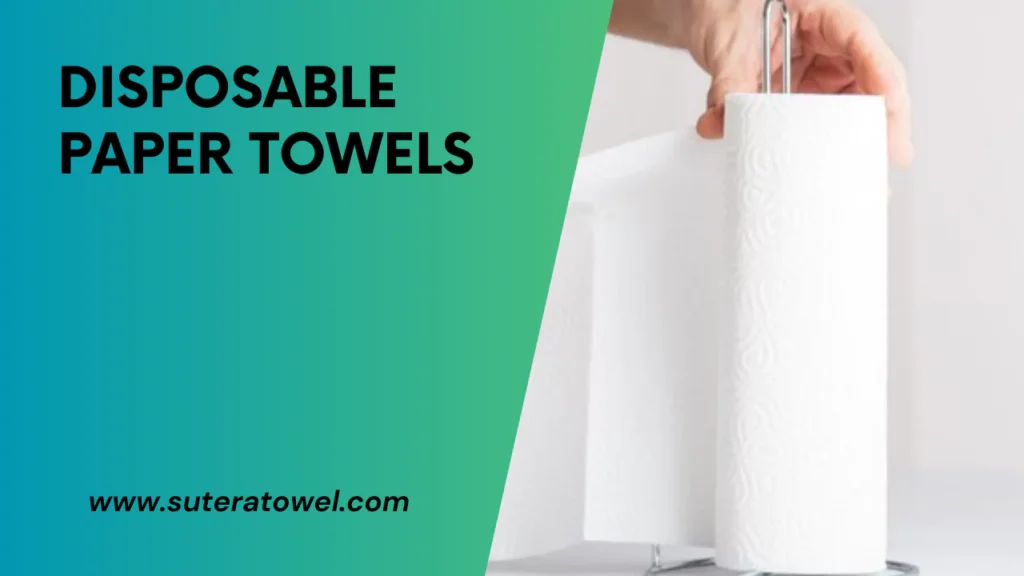
Disposable paper towels are a convenient and hygienic choice for maintaining sanitation in any setting. With their absorbent properties, they effectively clean up spills and prevent the spread of germs, ensuring a clean and safe environment.
Convenient And Hygienic Option
Looking for a convenient and hygienic option for your sanitation needs? Disposable paper towels can be the perfect solution! Whether you need them for one-time use or for travel purposes, these towels offer a range of benefits that make them a go-to choice for many.
In this section, we will explore why disposable paper towels are an ideal option, discussing their convenience and hygiene factors.
- Easy to use: Disposable paper towels are highly convenient as they can be easily accessed and used whenever needed. With their simple tear-off design, you can swiftly grab a towel and handle your sanitation needs without any hassle.
- Portable: These paper towels are lightweight and compact, making them travel-friendly. Whether you are going on a vacation, a business trip, or simply need a towel on the go, disposable paper towels are a reliable option. They take up minimal space in your bag and can easily fit into pockets without adding any significant weight.
- Versatile: Disposable paper towels are versatile in their applications. From cleaning surfaces to drying hands, these towels can fulfill a range of purposes. Their absorbent nature allows for efficient and effective cleaning and drying in various situations.
- Hygienic: As disposable paper towels are meant for single use, they promote a high level of hygiene. Unlike reusable towels, there is no risk of bacteria or germs multiplying in them, as you can dispose of them after use.
- Reduced risk of cross-contamination: Using disposable paper towels reduces the chances of cross-contamination. With every use, you can simply discard the towel, minimizing the spread of germs from one surface to another.
- Health and safety: Disposable paper towels play a significant role in safeguarding your health and safety. By using these towels, you can maintain proper hygiene standards, especially in public places or areas where access to handwashing facilities is limited.
- Environmentally friendly options: Many disposable paper towels are made from recyclable materials, providing an eco-friendly alternative. By opting for environmentally friendly options, you can contribute to reducing waste and protecting the planet.
Whatever your sanitation needs may be, disposable paper towels offer a convenient and hygienic solution. Their ease of use, portability, versatility, and hygiene factors make them an ideal choice for one-time use or travel purposes. So, next time you’re in need of a reliable sanitation option, consider reaching for disposable paper towels!
Bamboo Towels

Discover the exceptional cleanliness of bamboo towels, perfect for maintaining sanitation. Made from bamboo fibers, these towels provide lasting freshness and are gentle on the skin.
Sustainable And Eco-Friendly Alternative
Bamboo towels offer a sustainable and eco-friendly alternative to traditional sanitation towels. They are becoming increasingly popular due to their impressive qualities and minimal environmental impact. Let’s explore why bamboo towels are the preferred choice for those seeking a more sustainable approach to personal hygiene:
- Bamboo is a highly renewable resource that grows rapidly without the need for pesticides or fertilizers.
- Bamboo towels are biodegradable, reducing the accumulation of waste in landfills.
- The production of bamboo towels requires significantly less water compared to cotton towels.
- Bamboo fibers possess a natural antimicrobial property, inhibiting the growth of bacteria and reducing odors.
- The cultivation of bamboo promotes air quality by absorbing more carbon dioxide and releasing more oxygen than traditional trees.
In addition to their sustainability benefits, bamboo towels also stand out for their exceptional softness and durability:
- Bamboo fibers are extremely fine and soft to the touch, providing a luxurious and gentle feel against the skin.
- These towels are highly absorbent and have the ability to retain moisture, ensuring effective drying.
- With proper care, bamboo towels can withstand frequent use and numerous washes, maintaining their integrity over time.
- Bamboo towels are naturally hypoallergenic, making them suitable for individuals with sensitive skin or allergies.
By choosing bamboo towels, you not only prioritize sustainable living but also experience the comfort and functionality of a high-quality hygiene product. Say goodbye to conventional sanitation towels and embrace the eco-friendly revolution with bamboo towels.
Choose The Right Towel For The Task

Ensure optimum sanitation by choosing the right towel for the task at hand. Find the perfect sanitation towel to meet your specific needs for a clean and hygienic environment.
Sanitation towels are essential for maintaining cleanliness and hygiene, whether it’s for cleaning surfaces or personal use. However, not all towels are created equal. When selecting a towel for a specific task, it’s crucial to consider the material and purpose.
This will ensure that you choose the right towel that effectively meets your needs. In this section, we will explore two popular towel materials for different purposes: microfiber for cleaning surfaces and bamboo for personal hygiene.
Consider The Material And Purpose
When it comes to choosing the right sanitation towel, the material and purpose play a vital role. Let’s take a closer look at two popular options:
Microfiber For Cleaning Surfaces
- Highly efficient in capturing dirt and debris: Microfiber towels consist of tiny synthetic fibers that create an electrostatic charge, which attracts and traps dust, dirt, and other particles.
- Gentle on surfaces: Microfiber towels are incredibly soft and non-abrasive, making them suitable for delicate surfaces, including glass, stainless steel, and electronics.
- Absorbent and quick-drying: These towels have exceptional absorbency, allowing for efficient cleaning with minimal effort. Moreover, they dry quickly, reducing the chances of bacteria or mildew growth.
Bamboo For Personal Hygiene
- Antibacterial and hypoallergenic properties: Bamboo towels are naturally resistant to bacteria, making them an excellent choice for personal hygiene. They inhibit the growth of odor-causing bacteria, keeping you fresh and clean.
- Soft and gentle on the skin: The fibers of bamboo towels are incredibly soft and silky, providing a luxurious feel against the skin. They are suitable for individuals with sensitive skin or allergies.
- Sustainable and eco-friendly: Bamboo is a fast-growing and renewable resource, making it an eco-friendly choice. Choosing bamboo towels helps reduce your carbon footprint while enjoying their numerous benefits.
When selecting a sanitation towel, it’s essential to consider the material and purpose. Microfiber towels are ideal for cleaning surfaces due to their effectiveness in capturing dirt and their gentle nature. On the other hand, bamboo towels are perfect for personal hygiene, thanks to their antibacterial properties and softness.
By choosing the right towel for the task, you can ensure cleanliness and hygiene in various aspects of your life.
Sanitation Towel Maintenance
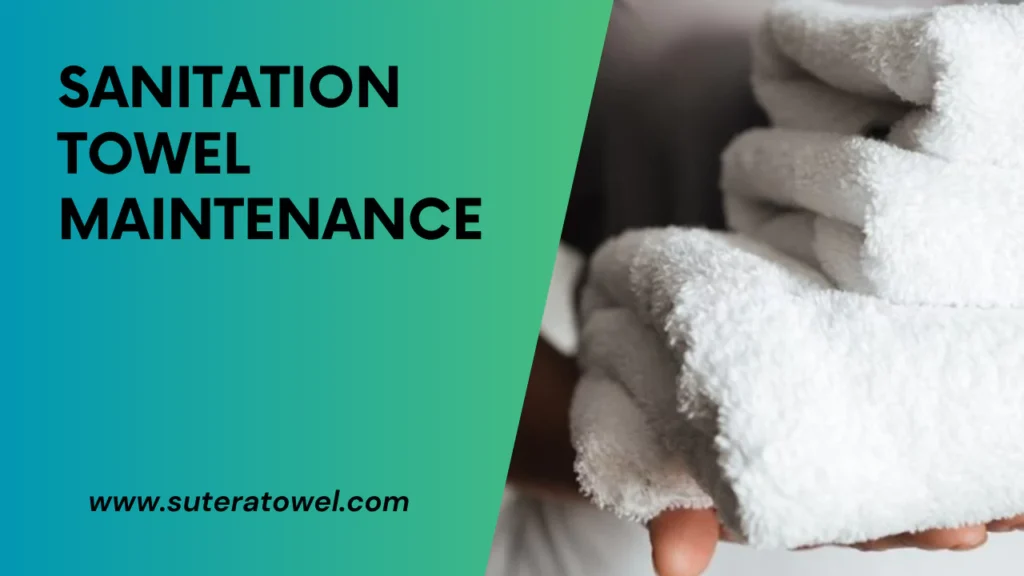
Maintaining cleanliness and hygiene is essential, and proper sanitation towel maintenance ensures optimal performance and longevity. Regular washing, thorough drying, and storage in a clean, dry place help to prevent bacteria growth, provide effective cleaning, and extend the life of sanitation towels.
Proper Washing And Drying Techniques:
- To ensure the longevity and effectiveness of your sanitation towels, it’s crucial to follow proper washing and drying techniques. Here are some guidelines to help you maintain your towels in top condition:
- Start by separating your sanitation towels from other laundry items to prevent cross-contamination.
- Check the towel label for any specific washing instructions.
- Use a mild detergent and avoid using fabric softeners as they can reduce the towel’s absorbency.
- Wash the towels in warm water to effectively remove dirt and bacteria.
- Consider using bleach or an antibacterial laundry additive for an extra level of cleanliness.
- Make sure not to overload the washing machine to allow thorough cleaning.
Proper drying is equally important:
- After washing, the towels should be dried completely to prevent mold or mildew growth. Here’s how you can achieve optimal drying results:
- If possible, air dry the towels outdoors to take advantage of the natural sunlight and fresh air.
- If using a dryer, select a low or medium heat setting to protect the towel’s fabric.
- Avoid over-drying, as it can cause the towels to become stiff and less absorbent.
- Shake the towels before folding them to fluff them up and restore their softness.
Remember, by following these proper washing and drying techniques, you can maintain the quality and effectiveness of your sanitation towels for longer.
Regular Cleaning Of The Towels To Prevent Bacteria Buildup:
- Over time, towels can accumulate bacteria and odors if not cleaned regularly. It’s important to establish a routine for cleaning your sanitation towels to keep them free from harmful microorganisms. Here are some tips to help you stay on top of regular cleaning:
- Wash the towels after each use to remove any dirt, debris, or bacteria.
- If the towels are heavily soiled, consider pre-soaking them in a mixture of water and detergent before washing.
- Avoid leaving wet towels in a confined space, as it can promote bacterial growth. Instead, hang them to dry in a well-ventilated area.
- If the towels have a lingering odor, add vinegar or baking soda to the wash to neutralize unpleasant smells.
- Make sure to follow the manufacturer’s recommendations regarding the towel’s lifespan and replace them when necessary.
By incorporating regular cleaning practices into your sanitation towel maintenance routine, you can ensure a hygienic and bacteria-free environment.
Tips For Optimal Cleanliness
Discover the top secrets to maintaining optimal cleanliness with these expert tips on sanitation towels. From choosing the right material to proper storage, you’ll learn all you need to know for a spotless and hygienic environment.
Sanitation towels play a crucial role in maintaining cleanliness and hygiene. Whether you’re working in a professional kitchen or simply practicing good hygiene at home, these tips will help you achieve optimal cleanliness while using sanitation towels:
Avoid Cross-Contamination
- Use color-coded towels: Assign different colored towels for different tasks to minimize the risk of cross-contamination. For example, you can use blue towels for sanitizing surfaces, green towels for food preparation, and red towels for wiping up spills.
- Replace towels regularly: Dirty towels can harbor harmful bacteria, so it’s important to replace them frequently. Set a schedule for replacing towels, ensuring that they are cleaned thoroughly between uses.
- Store towels properly: After use, store your sanitation towels in a clean, dry place to prevent the growth of bacteria. You can use designated towel bins or shelves to keep them organized and separate from other cleaning supplies.
Follow Proper Hand Hygiene Practices
- Wash hands regularly: Before and after using sanitation towels, wash your hands with soap and water for at least 20 seconds. This simple step helps prevent the spread of germs and ensures optimal cleanliness.
- Use hand sanitizer: When soap and water are not readily available, use an alcohol-based hand sanitizer with at least 60% alcohol content. Apply enough sanitizer to cover all surfaces of your hands and rub them together until dry.
- Avoid touching your face: It’s easy to inadvertently touch your face while using sanitation towels. However, this can transfer bacteria from your hands to your face, increasing the risk of infection. Be mindful of this and avoid touching your face with soiled hands.
Remember, maintaining optimal cleanliness while using sanitation towels is essential for preventing the spread of germs and ensuring a safe and hygienic environment. By following these tips, you can make the most of your sanitation towels and promote a clean and healthy space.
Hospitality And Food Service
Maintaining cleanliness and hygiene in the hospitality and food service industry is crucial. A sanitation towel is an essential tool that helps ensure a clean and safe environment for both guests and staff.
Sanitizing surfaces and utensils:
- Regular sanitation of surfaces and utensils is crucial in the hospitality and food service industry to ensure a safe and hygienic environment for guests. By following proper sanitization protocols, establishments can prevent the spread of harmful bacteria and viruses, ultimately safeguarding the health of their customers. Here are some key points to consider:
- Implement a regular cleaning schedule: Establish a routine for sanitizing surfaces and utensils to maintain cleanliness consistently. This includes cleaning food preparation areas, cutting boards, utensils, and any other surfaces that come into contact with food or guests.
- Use approved sanitizers: Make sure to use sanitizers that are approved by health authorities and meet the industry standards. These sanitizers should effectively eliminate germs and bacteria, providing optimal sanitation for surfaces and utensils.
- Train staff on proper sanitization techniques: Educate your staff about the importance of proper sanitization and train them on the correct techniques. This includes understanding the appropriate dilution ratios for sanitizers, the proper usage of cleaning equipment, and the necessary contact time for the sanitizer to be effective.
- Focus on high-touch areas: Pay special attention to high-touch areas such as door handles, light switches, faucets, and countertops. These areas are prone to frequent contact and require more regular sanitization to minimize the risk of contamination.
Promoting cleanliness in guest areas:
- Maintaining a clean and hygienic environment in guest areas is essential to provide a positive and enjoyable experience for visitors. Here are some key steps to promote cleanliness:
- Regular cleaning of guest rooms: Ensure that guest rooms are thoroughly cleaned and sanitized before each new arrival. This includes changing bed linens, sanitizing surfaces, vacuuming carpets, and cleaning bathrooms. Implementing a checklist can help ensure that no area is overlooked during the cleaning process.
- Adequate ventilation: Proper ventilation is crucial in preventing the buildup of stale air and odors in guest areas. It also helps to improve air quality by reducing the concentration of airborne contaminants. Regularly check and maintain ventilation systems to ensure optimal performance.
- Providing hand sanitation stations: Place hand sanitizing stations in strategic locations throughout guest areas, such as lobbies, dining areas, and restrooms. This encourages guests to maintain hand hygiene and reduces the risk of spreading germs.
- Regular inspections: Conduct regular inspections to identify areas that require additional cleaning or maintenance. This proactive approach helps address any potential cleanliness issues promptly and ensures a consistently clean environment for guests.
Remember, by following proper sanitation practices and promoting cleanliness, hospitality and food service establishments can create a safe and welcoming space for their guests.
Healthcare Facilities
Healthcare facilities prioritize hygiene with the use of sanitation towels, ensuring a clean and safe environment for patients and staff. These towels effectively aid in maintaining sanitation standards, reducing the spread of germs and infections.
Maintaining sterile environments:
- Regular cleaning and disinfection: Healthcare facilities should implement rigorous cleaning and disinfection practices to prevent the spread of infections. This includes frequent sanitization of surfaces, equipment, and patient areas.
- Proper disposal of medical waste: The correct disposal of medical waste is crucial to maintaining a sterile environment. Waste should be segregated and disposed of following established guidelines to minimize the risk of contamination.
- Air quality control: Filtered ventilation systems can help control the spread of airborne pathogens within healthcare facilities. Regular maintenance and cleaning of these systems are necessary to ensure proper air quality.
- Staff hygiene protocols: Healthcare professionals should adhere to strict hygiene protocols, such as proper handwashing techniques and the use of personal protective equipment (PPE), including gloves, masks, and gowns.
- Implementation of infection control programs: Healthcare facilities should have comprehensive infection control programs in place. These programs should include regular training for staff members, monitoring systems for identifying and addressing outbreaks, and protocols for isolating infected patients.
Preventing the spread of infections:
- Hand hygiene: Proper hand hygiene is one of the most effective ways to prevent the spread of infections. Healthcare professionals should wash their hands frequently and use hand sanitizers when necessary.
- Personal protective equipment (PPE): Healthcare workers should utilize appropriate PPE to protect themselves and others from infections. This includes gloves, masks, gowns, and eye protection.
- Isolation precautions: Isolating infected patients helps prevent the spread of infections to others. Healthcare facilities should have designated isolation areas and follow protocols for isolating patients with contagious diseases.
- Vaccinations: Healthcare workers should receive regular vaccinations to protect themselves and their patients from preventable diseases. This includes vaccines for common infectious diseases such as influenza and hepatitis.
- Patient education: Educating patients on proper hygiene practices and the importance of following infection control measures can help prevent the spread of infections within healthcare facilities.
Maintaining a sterile environment and preventing the spread of infections is vital in healthcare facilities. By implementing stringent cleaning practices, controlling air quality, emphasizing proper staff hygiene, and following infection control protocols, healthcare facilities can minimize the risk of infections and provide a safe environment for both patients and healthcare workers.
Office Spaces
Sanitation towel is essential for maintaining cleanliness in office spaces. It helps to prevent the spread of germs, keeping employees healthy and productive throughout the workday.
Maintaining Cleanliness In Shared Spaces
Office spaces are bustling hubs of activity where employees come together to work, collaborate, and share ideas. With multiple people using the same spaces, it becomes crucial to prioritize cleanliness and sanitation to ensure a healthy and productive work environment.
Here’s how implementing a sanitation towel can help in maintaining cleanliness in shared spaces:
Effective Removal Of Germs And Bacteria:
- The use of sanitation towels allows for the effective removal of germs and bacteria from commonly touched surfaces, such as desks, keyboards, and shared equipment.
- By wiping down surfaces regularly with sanitation towels, you can reduce the risk of spreading illness-causing pathogens, leading to a healthier workspace.
Quick And Convenient Cleaning:
- Sanitation towels offer a convenient cleaning solution, requiring minimal effort and time to use.
- With their pre-moistened and disposable nature, these towels enable quick and on-the-spot cleaning, ensuring shared spaces remain clean and presentable throughout the day.
Eliminating Unpleasant Odors:
- Shared spaces can sometimes become susceptible to unpleasant odors, especially in high-traffic areas like break rooms or meeting rooms.
- Utilizing sanitation towels infused with refreshing scents helps in eliminating unwanted odors, leaving a clean and pleasant environment for everyone.
Improving Employee Health And Well-Being
A clean and sanitized office space not only promotes physical health but also contributes to the overall well-being of employees. Here’s how the use of sanitation towels can have a positive impact:
Minimizing The Spread Of Illness:
- Regularly cleaning shared spaces with sanitation towels helps to minimize the spread of illness-causing germs and bacteria.
- By providing employees with a clean and hygienic environment, the chances of contracting common ailments are reduced, leading to fewer sick days and improved productivity.
Boosting Morale And Comfort:
- A clean and well-maintained office space sends a positive message to employees, promoting a sense of care and consideration for their well-being.
- The use of sanitation towels demonstrates a commitment to cleanliness, contributing to greater employee morale, comfort, and job satisfaction.
Enhancing Focus And Concentration:
- Cluttered and unclean workspaces can be distracting, hindering employee focus and concentration.
- By regularly using sanitation towels to keep shared spaces clean and organized, distractions are minimized, allowing employees to stay focused and perform at their best.
Prioritizing cleanliness in office spaces is essential for a healthy and productive work environment. Implementing the use of sanitation towels offers an effective and convenient way to maintain cleanliness in shared spaces, while also improving employee health and well-being. By adhering to good sanitation practices, organizations can create a workspace that promotes productivity, positivity, and success.
Frequently Asked Questions Of Sanitation Towel
What Is A Sanitation Towel?
A sanitation towel is a hygienic product used for personal care during menstruation or for general cleaning purposes.
Which Side Of The Sanitary Pad Goes In The Front?
The front side of the sanitary pad should face the front.
Are Paper Towels Clean?
Yes, paper towels are clean and safe to use.
How Does A Towel Work?
A towel works by absorbing moisture from your body and surfaces through its fibers.
Conclusion
Sanitation Towel is an essential product that offers numerous benefits for personal hygiene and cleanliness. With its innovative features and high-quality materials, it provides a convenient and effective way to maintain sanitation in various settings. Whether you’re at home, in the office, or on the go, this towel is a versatile solution to keep yourself and your surroundings clean.
Its absorbency and durability make it an ideal choice for everyday use, while its compact and portable design ensures easy storage and transportation. By investing in Sanitation Towel, you’re not only prioritizing your own well-being but also contributing to a safer and healthier environment for everyone.
So, consider incorporating this smart and eco-friendly product into your daily routine and experience the difference it can make.
